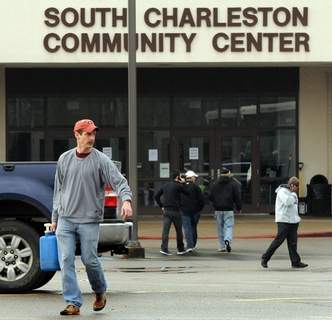
South Charleston resident Bil Lepp carries a jug of water out of the South Charleston Community Center on Jan. 10, the day after a chemical leak from Freedom Industries contaminated the water for thousands of West Virginia American Water customers.
CHARLESTON, W.Va. — Roughly 100,000 residents may have suffered skin reactions, eye irritation, nausea or other ailments after exposure to MCHM following the January leak of the chemical into the Kanawha Valley’s Elk River water supply, according to new estimates made public Tuesday.
The estimates are based on physician reports to the Kanawha-Charleston Health Department and a household survey conducted by a University of South Alabama environmental engineer who was later hired by Gov. Earl Ray Tomblin to investigate the impacts of the Freedom Industries leak.
Dr. Rahul Gupta, executive director of the Health Department, said his calculations put the number of people who experienced such symptoms at nearly 93,000. Using slightly different calculations, environmental engineer Andrew Whelton, who is a leader of Tomblin’s West Virginia Testing Assessment Program, put the figure at just less than 109,000.
Their reviews — which have yet to undergo peer review or be published in a scientific journal — project far greater public health impacts on the region’s residents than numbers previously released by the state Department of Health and Human Resources.
The DHHR previously had said that 26 people were admitted to area hospitals and 533 treated at released at those facilities for symptoms that could have been related to the leak. Those figures did not include any data for the day of the Jan. 9 leak or the day after. Also, the DHHR tracked only hospital treatments or admissions, and agency officials stopped counting after Jan. 23, records show.
“Those are probably gross underestimates of the true public health impacts,” Gupta said. “It’s the tip of the iceberg…”






